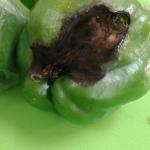Solanaceous, Alternaria Fruit Rot
Alternaria alternata
Alternaria fruit rot generally occurs in fruit having a predisposing injury. The Alternaria species responsible is a weak pathogen and rarely spreads in harvested fruit. The fungus has been reported on a wide range of fruits and vegetables but is especially common on pepper fruit which has been injured due to sunscald.
Identification:
Lesions may develop at growth cracks, wounds, or on tissue that has been damaged by chilling, sunscald, calcium deficiency, insect injury, or heat. As the disease progresses, lesions enlarge and become become sharply sunken. The lesions eventually become covered with a dark green to black mold.
Life Cycle:
A. alternata exists naturally as a saprophyte and is one of the first colonizers of dying plants. Primary inoculum is airborne and originates on debris of a wide variety of plants. Initial infections of pepper can start on the flower leading to internal rot, on wounded tissue, or on drying stems. As the fruit ripens it becomes more susceptible to infection. Alternaria fruit rot is favored by warm temperatures and is greatly reduced by refrigeration.
Cultural Controls & Prevention:
- Avoid conditions that predispose pepper fruit to infection in the field and after harvest.
- Schedule planting so that harvest does not occur during very hot or very cold weather.
- Select cultivars that provide good shading of developing fruit.
- Ensure that fertilization provides adeqaute calcium.
- Avoid rough handling during harvest.
- Harvested fruit should be promptly cooled to 35-40 F.
- There are no approved fungicides or biocontrol agents for post harvest application to pepper.
Chemical Controls & Pesticides:
For Current information on disease recommendations ins specific crops including information on chemical control & pesticide management, please visit the New England Vegetable Management Guide website.
Crops that are affected by this disease:
The Center for Agriculture, Food and the Environment and UMass Extension are equal opportunity providers and employers, United States Department of Agriculture cooperating. Contact your local Extension office for information on disability accommodations. Contact the State Center Director’s Office if you have concerns related to discrimination, 413-545-4800 or see ag.umass.edu/civil-rights-information.

